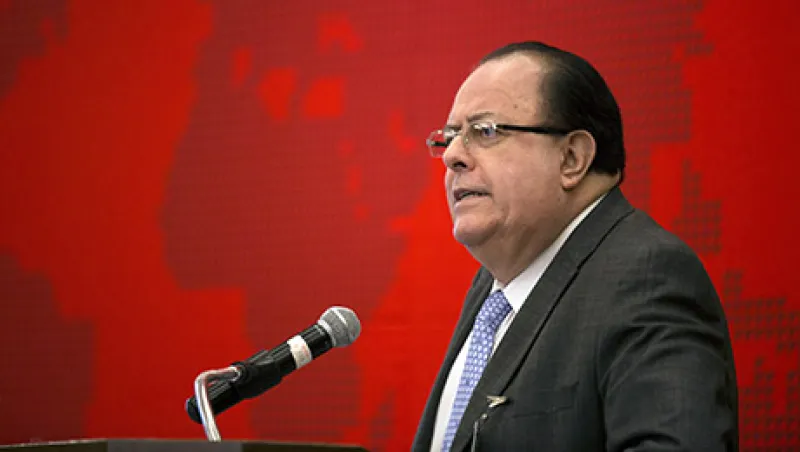Peru’s recent rate cut has just about exhausted the central bank’s room for monetary easing, putting the onus on the government to undertake wide-ranging structural reforms to set the economy back on a strong growth track, the country’s central bank chief says.
On September 11 Banco Central de Reserva del Perú cut its reference interest rate by 25 basis points, to 3.5 percent, citing weaker economic growth and lower-than-expected inflation figures. Since then, inflation has ticked up: to 3.09 percent in October — above the target range of 2 percent plus or minus 1 point — from 2.74 percent in September.
“We have not made further rate cuts to stimulate the economy because inflationary pressures built up in October,” Julio Velarde, who has been at the helm of the central bank since 2006, says in a telephone interview. “Structural reform is vital to maintain rapid economic growth. There is too much bureaucracy. For example, 4,200 permits are needed to build a gas pipeline; that is way too many. It is very hard to fire people; this has created a very big informal economy. Reform of the labor laws is essential.”
The government of President Ollanta Humala has begun to take action to spur the economy. In September Humala dismissed his finance minister, Luis Castilla, and replaced him with the ministry’s chief adviser, Alonso Segura. On November 20 Segura announced plans to seek congressional approval for a package of tax cuts that would reduce the corporate tax rate by 2 percentage points, to 28 percent, and slash taxes on low-income Peruvians. In addition, the minister said the government plans to issue $1 billion in bonds to finance short-term spending and public sector investments.
“Peru is very much a mining and primary-resources story from an investors’ perspective,” says Jan Dehn, head of research at Ashmore Group, the London-based emerging-markets investment manager. “Mining and infrastructure projects require a lot of lead time, and I think the government now has a sense of urgency to award megaconcessions beyond 2015.”
Peru has enjoyed economic growth at an average rate of 6.4 percent a year over the past decade, but a steep drop in commodities prices is expected to slow the rate of expansion to just 3 percent in 2014, the slowest pace since the crisis year of 2009, according to the central bank. The country is a leading producer of copper, silver and gold; mining generates 15 percent of its $208 billion gross domestic product and some 60 percent of export earnings. Copper prices are down 12 percent this year, whereas silver prices have declined 20 percent.
The tax cuts are intended to boost growth above 5 percent in 2015, said Segura in his announcement. The central bank, meanwhile, lowered bank reserve requirements by half a point, to 10 percent, on November 2 in a bid to increase liquidity in the financial system to counteract the economic slowdown. The central bank has aggressively reduced the reserve requirement since June 2013, when it stood at 20 percent. It is forecasting that the economy will grow by 5.5 percent next year, although most private forecasts are around 5 percent.
Peru boasts some of the best economic fundamentals in Latin America. Despite the slowdown, the economy is still growing, unlike that of its neighbor to the east, Brazil. The Peruvian government ran a budget surplus of 0.9 percent of GDP last year. In October the central bank had reserves of $62.6 billion. Moody’s Investors Service raised its credit rating on Peru by one notch, to A3, in July, citing the government’s strong fiscal position and prospects for an economic rebound. The rating is the same as Mexico’s and is exceeded in Latin American only by Chile.
Yet tumbling commodities prices led the country to record its first trade deficit in more than a decade last year. The deficit is expected to widen to more than $2.5 billion in 2014, from $365 million last year, according to the central bank. Gold exports, for example, declined 17 percent in the first nine months of this year.
“The terms of trade have got worse,” says Velarde. “A supply shock in agriculture this year has not helped. But the trade deficit should start to be reversed next year.” Agricultural output is expected to grow by a modest 2 percent this year, roughly half the long-term growth rate, because of a drought in the north of country at the start of the year.
During the past few months, the government has embarked on a series of reforms to kick-start growth, including a loosening of environmental rules, increased spending on health and security, a commitment to lock in tax rates for big mining projects and measures aimed at cutting red tape. The Congress has been debating whether to free up the labor market but hasn’t passed any legislation yet. Economists say laws giving employees the right to 30 days vacation a year and requiring employers to provide health insurance benefits are hindering job growth and keeping much activity — an estimated 60 percent of GDP — off the books in the informal sector.
“It’s too hard to fire people,” says Velarde. “It’s similar to Spain or Italy. This means that new entrants to the labor market are normally placed on temporary contracts.”
A slowdown in the granting of new mining permits has also hit the economy, analysts say. Humala is the founder of the left-wing Peruvian Nationalist Party and draws electoral support from the country’s indigenous population, which opposes many mining projects.
“All the new regulations really started to slow down the economy,” says Pablo Moreyra Almenara, founder of EQUBO, a Peruvian strategic consultancy. “It led to a delay in big projects, and the government has spent a lot of time this year attempting to convince the international investor community to return.”
A large number of mining projects are expected to begin next year or in early 2016. Shougang Corp., a Chinese steel company, is spending $1.5 billion to expand an iron mine at Marcona on the Pacific coast. Bear Greek Mining, a U.S.-Peruvian company, is investing $750 million in a silver mine at Corani in the country’s southeast.
MMG, another Chinese mining company, says its huge Las Bambas copper project, located in southern Peru, will start operations in early 2016, rather than late next year, as was previously expected. MMG led a consortium that bought the mine from Glencore, the Anglo-Swiss mining and commodities giant, for $7 billion in late August. Freeport-McMoRan, the U.S. copper and gold producer, is spending $4 billion to double production at Cerro Verde, a giant open-pit copper and molybdenum mining complex, by 2016.
“There is a whole array of projects expected to start during the next two years,” says central banker Velarde. “Copper production should double by 2017.”
However, in a sign of the difficulties facing some mining projects, the proposed $5 billion Conga copper and gold project by U.S.-based Newmont Mining Corp. could remain on hold for four years. The project was originally scheduled to begin production next year, but its main opponent, Gregorio Santos, was re-elected in October for a second four-year term as regional president of the gold-rich Cajamarca region (despite being jailed in June on charges of bribery and collusion). Opponents say the mine would pollute and drain local water supplies.
The government is also attempting to stimulate the economy through infrastructure investments, including the start of construction this year on the $5.6 billion second Metro line in Lima. A consortium led by Finmeccanica, the Italian industrial group, and Grupo ACS, the Spanish civil engineering company, is building and will operate the 35-kilometer (22 mile) line under a 35-year private-public concession. The government will put about $3.8 billion into the project.
In July a consortium led by Odebrecht, the Brazilian construction firm, and Enagas, the Spanish utility company, won a contract to build and operate a $4 billion natural gas pipeline in southern Peru. It will take five years to construct and is central to the government’s plans to develop a petrochemical hub in the region and increase the electricity supply for mining projects.
“The Ministry of Finance has now put in place a specialized team to prioritize certain projects,” says Carlos Herrera, executive director of Proinversion, the country’s private investment promotion agency. “They are establishing a fast-track process for some of the most important mining and infrastructure projects. Four or five huge mining projects are expected to start next year, and this will lead to a pickup in growth.”
In late October Peru tapped the international bond markets for the first time in two years in an effort to reduce borrowing costs and extend maturities. It sold $500 million of its dollar-denominated notes due 2050 at a yield of 1.85 percentage points over U.S. Treasuries and the equivalent of $500 million in sol-denominated notes due in 2024. Peru offered to buy back sol bonds — known as soberanos — maturing in 2015 and 2020 and dollar notes due 2015, 2016 and 2019. The refinancing moves Peru closer to its target of reducing dollar-denominated debt to 30 percent of total obligations by 2017, from 50 percent last year.






